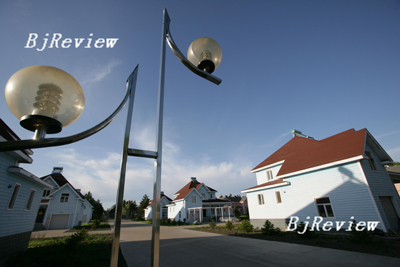
Puyang Farm, 600 km from Harbin, capital city of Heilongjiang Province, is an ordinary plot among holdings in the Beidahuang reclamation area. Developed in 1971, it is now a state-owned mechanized major grain producer. There is nothing to tell of its past except for a sculpture at its entrance.
Nobody would associate the prosperous farm with the deserted wasteland it once was.
There are four rivers running through the farm of which the Songhuajiang River is the largest. The underground water level is 2-3 meters and changes with the flow of the rivers, which used to break their banks flooding the area in spring and autumn before reclamation, leaving only weeds.
Reclamation of the area began on October 3, 1970, when Lu Quansheng, head of Tangyuan Farm, led an eight-member team on the first field investigation of the swampland.
They encountered "a vast wasteland in the mist," and "after we walked about 100 steps into the wasteland, thick weeds as tall as a person began to separate us like a tight wall, " according to a description of their exploration in The History of Puyang Farm. Members of the field team called to each other to keep in contact as they trod a path through the weeds, stopping to collect soil and vegetation samples. It took them three days to complete that first investigative trip and reach the end of the swampland.
"They discovered the wasteland was a fertile one and decided to reclaim it with a detailed reclamation plan," said Li Xiuying, a worker on the farm. "They also proposed to raise the banks of Songhuajiang River in order to lower the flood into the swampland."
According to The History of Puyang Farm, the reclamation team opened up around 1,300 hectares, or 5 percent of the farm's total area in about one month before the land froze on November 11.
On January 23 the following spring, nearly 2,000 residents from the adjacent Tangyuan Farm moved to the wasteland to establish a new holding, Puyang Farm.
"They built on nothing but the opened land of 1,300 hectares, and made the layout on the spot with wicker, handkerchiefs and things they could find or take with them," said Li. "The most difficult part was their first meal on the wasteland, which took them five hours to prepare as the temperature was more than 30 degrees below zero," said Gu Yi, head of Puyang Farm today. "They had to dig into the frozen land to set up a boiler and melt ice and snow for water."
The farm has developed at a speed of 2,000 hectares every year to today's size and was fully established in 1981.
Infestation
Soon after its establishment, the farm experienced several major disasters.
The first was a fire two months after it was first built, which 700 workers were mobilized to put out. That fire, and a second which took place half a month later, burned farm buildings and 300 hectares of woods nearby, leaving one dead and five injured.
| 